Saturday – Leominster – Early mornings are now dark and cool but this has not stopped bats feeding over the Grange. One jinks around my head as I enter the playing field. Jupiter is very prominent at the moment. Through a telescope, its moons are like a line of diamonds. The day turns very warm and ultimately rather unpleasantly oppressively humid. The garden is very dry again and the water butts nearly empty. I start removing the French beans, laying out the fat pods to dry. During the late evening walk with Maddy a shooting star flashes across the western sky.
Monday – Bodenham Lake – It is very warm and I am wondering why on earth I am wearing a fleece. The water level is getting even lower on the lake and it looks like pea soup with a sprinkling of finely chopped parsley. A Great Crested Grebe, either a juvenile or an adult already in winter plumage, preens. There are four Grey Herons around. One is on the spit, stationary; another on the end of the spit objecting to the presence of some Teal and two others chasing across the lake. A dozen or more Cormorants are around the site. A pair of Mute Swans with three cygnets float around near the northern reed bed. A small horse has got onto the bank in front of the hide and grazes contentedly. I gather up a rucksack full of cider apples from the ground in the orchard. The diagram identifying the trees is a little confusing as paths are not where they are indicated. I think the varieties are a Broxwood Foxwhelp and a Stoke Red. They produce nearly two gallons of juice. They are both a bit high in acid, so I will have to find a low pH variety to blend in.
Tuesday – Leominster – I notice that the perry pear tree in the Millennium Park has dropped most of its fruit. When it gets light I return and collect a couple of bagfuls. The only apples left now are Dabinett which always fall late. Back to the car and off to Bodenham.
Bodenham Lake – I do not tarry long, just enough time to collect some more fruit. There is only one perry pear tree with any fruit and most of that is scattered thickly on the ground. It is called “Dead Boy” on account of its taste and a quick bite explains why. It is very sweet and utterly devoid of acid, quite a foul fruit. Across the orchard to another tree which has a lot of apples underneath. I am not collecting them today but I try one and it is actually worse that Dead Boy. Not only very sweet and bland but it is also very mealy – disgusting. My target tree is over further, “Bulmers Norman”, introduced from France about a century ago by the famous cider makers. This apple has more crunch and is juicier than the last, but again very low acid and certainly not something I would wish to eat. However, I have already got a couple of gallons of juice from yesterday’s pickings and they both have higher acid levels, especially Foxwhelp, so this morning’s apples will blend in well – I hope.
Wednesday – Caynham – A village to the south-east of Ludlow. Through the churchyard and into a field that has a wide band of set-aside around the ploughed and harrowed soil. The footpath climbs a gentle slope up towards Caynham hillfort which sits on the skyline. An old sunken trackway, lined by Oaks, runs up the edge of the field. It has been filled in 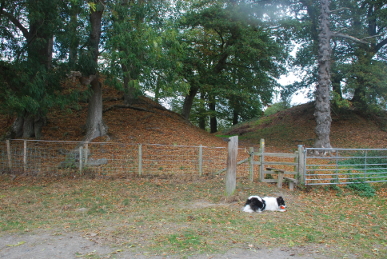 towards the top and a wall built behind a large concrete water trough. Beyond the wall is a deep, old quarry which would have provided the stone which built the village. On up the hill and the path crosses another field to arrive at a large in-turned entrance to the fort. The defensive ramparts here are over fifteen feet high. There is a second rampart, much lower due to ploughing, on the southern side. The northern side has a steep slope down to Cay Brook. The camp is univallate and has an annex at the western end with a bank between the main body of the fort and the annex. It has been suggested there was an entrance on the northern side as well as the main one to the east. The walls were faced with stone with wooden palisade on top. There were three or four major periods of development between about 600BCE to 100BCE. Excavations between 1956 and 1961 revealed circular houses and granaries. Leyland believed there was a mediaeval castle here, but this was not the case. It is also said that Cromwell camped here during the siege of Ludlow in 1646. Another legend is that the camp was called Castle Key, Kensham Castle or Keyenhom Castle. Joce de Dinan and seven thousand men occupied this castle prior to laying siege to Walter de Lacy and his troops in Ludlow Castle in 1144. According to Fulk Fitzwarren, the
towards the top and a wall built behind a large concrete water trough. Beyond the wall is a deep, old quarry which would have provided the stone which built the village. On up the hill and the path crosses another field to arrive at a large in-turned entrance to the fort. The defensive ramparts here are over fifteen feet high. There is a second rampart, much lower due to ploughing, on the southern side. The northern side has a steep slope down to Cay Brook. The camp is univallate and has an annex at the western end with a bank between the main body of the fort and the annex. It has been suggested there was an entrance on the northern side as well as the main one to the east. The walls were faced with stone with wooden palisade on top. There were three or four major periods of development between about 600BCE to 100BCE. Excavations between 1956 and 1961 revealed circular houses and granaries. Leyland believed there was a mediaeval castle here, but this was not the case. It is also said that Cromwell camped here during the siege of Ludlow in 1646. Another legend is that the camp was called Castle Key, Kensham Castle or Keyenhom Castle. Joce de Dinan and seven thousand men occupied this castle prior to laying siege to Walter de Lacy and his troops in Ludlow Castle in 1144. According to Fulk Fitzwarren, the 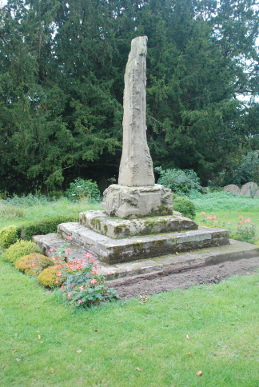 castle was built by Kay, however, as stated above there is no evidence of any such building on the site. The tops of the bank are wooded with old Beech trees, a pity as trees always obscure the form of the hillfort, but far better than the brutal conifer plantations on a number of local sites.
castle was built by Kay, however, as stated above there is no evidence of any such building on the site. The tops of the bank are wooded with old Beech trees, a pity as trees always obscure the form of the hillfort, but far better than the brutal conifer plantations on a number of local sites.
Back down to the church past a wonderful old stump of a substantial tree, crowned by Ivy. Caynham at Domesday was in the Hundred of Overs and had been the property of Earl Morcar. After the Conquest it was managed of Ralph de Mortimer on behalf of Earl Roger of Montgomery. The name comes from the Old English of Cægin’s Hamm meaning Cægin’s village. The church of St Mary was first recorded in 1179 and the following year Caynham was given to Wigmore Abbey by Hugh de Mortimer. By 1881 the church was in a ruinous state and was rebuilt by Emmanuel Stead under the direction of the London architect, James Brookes. Thus only a small part of the Norman church can be discerned. There is a fine square rubblestone tower. A wheeled bier stands in the northern aisle beneath deep lancet windows. On the south of the chancel is a window dedicated to the “Hunting Parson”, the Revd James Sidney Dundas Rider. Outside is a 14th century preaching cross, much eroded but the remains of elaborate carving can be made out.
Friday – Hergest Ridge – The gales of the last couple of days have subsided a bit. The sky is still covered by heavy grey clouds sweeping rapidly eastwards where the sun gleams through cracks. It is cool up on the ridge. Ahead someone is driving dogs with whistled commands. It is getting more misty over New Radnor, I suspect it is rain so I take the precaution of donning my over-trousers. The cold wind reminds me I will have to search out my woolly hat and scarf! The rain is more a dampness of a mist. A patch of sunshine appears briefly to the north-west, on The Smatcher, one of the hills south of New Radnor. A Skylark stutters a brief song above the brown bracken covered hill. Ravens cronk and dance in the wind. A herd of ponies stand before the summit. They trot away, one passing wind loudly in my direction.
Monday – Bodenham Lake – High winds and grey skies, but it is still mild. Yesterday a Hummingbird Hawkmoth was hovering around the flowers on the patio at home. Across to the cider orchard where a sign forbids the collecting of fruit as they are going to be sold to a local producer to raise money for the nature reserve. This seems a bit rich given that all of the perry pears have now rotted and many of the apples are lying on the ground, also rotting! The gravel spit off the island is crowded with a flock of Canada Geese interspersed with over twenty Cormorants. A Grey Heron stalks the shallows under the Birches on the island. The main areas of open water are void of birds. A pair of Mute Swans and their cygnets feed at the southern end of the lake. A few Tufted Duck preen off the end of the spit. Mallard are upended in the channel between the two areas of the lake.
Thursday – Mortimer Forest – It is a truly autumnal day. The path is like a soft, thick pile carpet as I tramp across a dense layer of pine needles. A fine drizzle falls from a uniform soft grey sky. Birch leaves are a mixture of yellow and green, and likewise the bracken, rust and green. A Pheasant is croaking in the distance otherwise all the birds are too busy fattening themselves for the lean months ahead to waste time on calling. The pond at the foot of the Deer Park is still dry. Up through the woods and onto the path again. Today I have a problem with people and their dogs. It starts now as a couple of dogs bound towards Maddy. “They’re all right”, calls out one of the women. “She’s not”, I respond. Maddy is at heel but two dogs running at her are a threat to her – so she attacks. I tell her to get her ball and walk on, which she does. The other dog’s owner call them back and grab their collars, then glare at me as if it is my fault their dogs approached mine, who did not like it! Later on, there are more people with several dogs and I have no difficulty in telling Maddy to keep going and ignore them. The owners, or at least one of them, have difficulty in keeping control of their dogs. “It’s difficult, isn’t it”, one states. I bite my tongue whilst thinking, you have gun dogs, they can be trained to obey implicitly every command, but you choose not to train them! Oh well, up through the woods again where little slimy capped boletus fungi grow on the path. The higher I go, the thicker the mist becomes and by the time I reach High Vinnalls visibility is down to about twenty yards. Not surprisingly, there are no views to be had today. Back down across Climbing Jack Common where Japanese Umbrella fungi peek through the grass. Back to the car park where there is another group of dog owners who are causing trouble. They have no control of their dogs which are running across the car park road, in front of cars exiting the place. They chase after Maddy who, fortunately is too preoccupied with getting back to the car to worry about them.
Friday – Wolverhampton – Bantock House and park is in Wolverhampton, a little south-east of Wightwick House which we have visited before. The house was called Merrifield Farm when it was built in 1730 and added to substantially in the early 19th century. It became the residence of the Bantock family in 1864. Both Thomas Bantock, a successful canal and railway agent, and his son, Baldwin, became Mayor of Wolverhampton. Baldwin married Kate (Kitty) Jones in 1889. They were childless and left the house to the town. The house is now a museum. On the ground floor is a room with a magnificent open fireplace with an Arts and Crafts copper cowling. On the first floor are displays recalling the people and businesses that made Wolverhampton an industrial centre. The walls are lined with Victorian paintings of that particularly mawkish and sentimental style. The park is a large, open space. The whole is a credit to municipal enterprise.
Uttoxeter – We weave through narrow streets around the market to reach our hotel, a rather fine Georgian Town House converted into a pub and hotel. We start to explore but immediately come up against that old bugbear - the parish church St Mary the Virgin, opposite the hotel is locked. Uttoxeter reputedly has had 79 spellings since it was mentioned in the Domesday Book as Wotocheshede, probably came from the 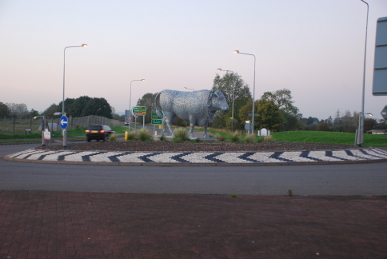 Anglo-Saxon Wuttuceshæddre meaning “Wuttuc’s homestead on the heath”. The discovery of Bronze Age axes in the town points to earlier settlement and it is also possible there was some Roman township here. So into the town centre. Part of it has some Georgian and Victorian buildings with the occasional earlier timber-framed one but there is a huge hole in the town consisting of a 60s or 70s shopping development and large car park. The whole is so depressingly familiar. The same budget shops, the same empty shops, the same decay as Barnsley. A stone built, square edifice at the end of the market is called the Johnson Memorial and records Dr Samuel Johnson, whose father sold books in this market and stored them in a building that is now a pub, stood in penitence here, in the rain without a hat, because, as a youth he refused to help his father. Down on the by-pass large statues adorn the roundabouts – a bull on one, a centaur on another.
Anglo-Saxon Wuttuceshæddre meaning “Wuttuc’s homestead on the heath”. The discovery of Bronze Age axes in the town points to earlier settlement and it is also possible there was some Roman township here. So into the town centre. Part of it has some Georgian and Victorian buildings with the occasional earlier timber-framed one but there is a huge hole in the town consisting of a 60s or 70s shopping development and large car park. The whole is so depressingly familiar. The same budget shops, the same empty shops, the same decay as Barnsley. A stone built, square edifice at the end of the market is called the Johnson Memorial and records Dr Samuel Johnson, whose father sold books in this market and stored them in a building that is now a pub, stood in penitence here, in the rain without a hat, because, as a youth he refused to help his father. Down on the by-pass large statues adorn the roundabouts – a bull on one, a centaur on another.
Saturday – Uttoxeter – A surprise to start the day, a heavy frost. Ice coats the car windscreen. I try to find somewhere for Maddy to have a run but it is difficult. Eventually a footpath off the Derby road is located. It leads into a field, pale frost coated grass and a low lying thin mist. Her ball is dutifully thrown and chased, then back to the hotel for breakfast. Off then to an Antiques Fair being held at Uttoxeter Racecourse. Kay states it will be fun although we will not buy anything - as if! We end up with an odd Malaysian pot, a Newport Pottery, Burslem Chinese blue pattern meat plate and a splendid tin sign advertising Oxo.
Rocester – A village to the north of Uttoxeter and once an important Roman military centre. We fail to find any sign of the Romans but plenty of a local company started by Joseph Cyril Bamford in 1945 making excavators. The company is now JCB, the world’s third largest construction equipment manufacturer.
Norbury – A small village near Ashbourne on the Staffordshire/Derbyshire border. On a hillside stands Norbury Manor, a 15th century manor house with an adjoining hall dated from the 13th century. The Fitzherberts were Lords of the Manor from the 12th century. William Fitzherbert built the old Manor Hall and Ralph, the Elizabethan house. The buildings were damaged by Parliamentarian troops during the Civil War and fell into a ruinous state. They were rebuilt by Sir John Fitzherbert around 1680. The buildings are still tenanted whilst being in the ownership of the National Trust and are, unfortunately not open when we visit. But the closely nearby church of St Mary and St Barlok is open. John Gisborne writes in his loco-descriptive poem, “Vales of Wever”:
A weird enough ditty, particularly as the church tower has no spire, so hardly “soars”! The layout of the church is unusual. The chancel and nave are almost the same length, there is a north aisle, but where the south aisle should stand is the 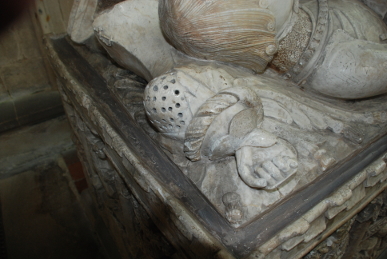 tower with a small chapel either side. St Barlok was an Irish bishop and saint. The site was probably pre-conquest as two Saxon cross shafts stand in the church. The present church dates from around 1300 when the chancel was built. The nave, tower and chapels date from the 15th century. In one of the small chapels is the plain tomb of Sir John Fitzherbert, the other has the tomb of Sir Henry with effigy of a knight. The main glories of the church are in the chancel, two superb tombs and extensive glass. The north and south chancel windows are recently restored and display many coats of arms dating from 1300 to 1305. The great East window was fully restored in the late 20th century after the original 14th century windows had been removed in 1770 and the window bricked up. The glass was sold some fifty years later. The window was reopened in 1842 and the 15th century glass from the rest of the building patchworked in. The tombs in the
tower with a small chapel either side. St Barlok was an Irish bishop and saint. The site was probably pre-conquest as two Saxon cross shafts stand in the church. The present church dates from around 1300 when the chancel was built. The nave, tower and chapels date from the 15th century. In one of the small chapels is the plain tomb of Sir John Fitzherbert, the other has the tomb of Sir Henry with effigy of a knight. The main glories of the church are in the chancel, two superb tombs and extensive glass. The north and south chancel windows are recently restored and display many coats of arms dating from 1300 to 1305. The great East window was fully restored in the late 20th century after the original 14th century windows had been removed in 1770 and the window bricked up. The glass was sold some fifty years later. The window was reopened in 1842 and the 15th century glass from the rest of the building patchworked in. The tombs in the 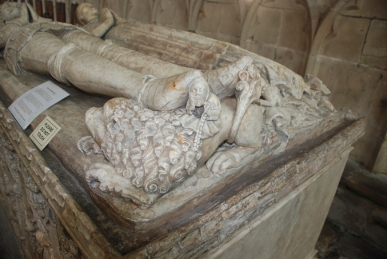 chancel have been described as the best examples of alabaster carving in the country. I cannot comment on such claims but they are indeed very fine specimens. They are the work of sculptors from Tutbury. One tomb has the effigy of Nicholas Fitzherbert who died in 1473 and the other Ralph Fitzherbert and his wife, Elizabeth who died in 1483 and 1496 respectively. The tombs were probably ordered by Ralph’s son John. The detail on the effigies is superlative – links of chainmail coifs are intricately shown, the fittings of the knights’ armour, the curls of hair in the manes of lions at their feet, lions that have tiny handlers holding a chain attached to a collar, the delicate neckpiece worn by Elizabeth and many other details. The effigies’ heads rest on a gauntlet, heraldic symbol of the family. Between the tombs are brasses of Sir Anthony Fitzherbert and his second wife, Dame Maud. Sir Anthony was a judge of great renown and author of “La Graunde Abridgement” and “L’Office et l’Auctorité de Justices de Paix”, once standard authorities for lawyers although long forgotten now.
chancel have been described as the best examples of alabaster carving in the country. I cannot comment on such claims but they are indeed very fine specimens. They are the work of sculptors from Tutbury. One tomb has the effigy of Nicholas Fitzherbert who died in 1473 and the other Ralph Fitzherbert and his wife, Elizabeth who died in 1483 and 1496 respectively. The tombs were probably ordered by Ralph’s son John. The detail on the effigies is superlative – links of chainmail coifs are intricately shown, the fittings of the knights’ armour, the curls of hair in the manes of lions at their feet, lions that have tiny handlers holding a chain attached to a collar, the delicate neckpiece worn by Elizabeth and many other details. The effigies’ heads rest on a gauntlet, heraldic symbol of the family. Between the tombs are brasses of Sir Anthony Fitzherbert and his second wife, Dame Maud. Sir Anthony was a judge of great renown and author of “La Graunde Abridgement” and “L’Office et l’Auctorité de Justices de Paix”, once standard authorities for lawyers although long forgotten now.
Ashbourne – A town at the southern end of the Derbyshire Peaks. The town grew substantially during the Georgian period through the coach trade as it is the junction of five major routes, including Manchester to London. The town declined somewhat after the railways eclipsed the stage coach. Most towns in this area developed because they stood on the River Dove, but this water is some way from Ashbourne which is traversed by a rather insignificant stream called the Henmore or Schoo. The town centre has an excellent selection of shops including a fine bakery selling artisan breads and delicious pies, we sample the Dovedale pie, mince with a layer of potato topped with Sage Derby cheese. A game dealer advertises venison and wild boar and “fish from Grimsby”. We are not stopping long so we walk as far as the parish church. The 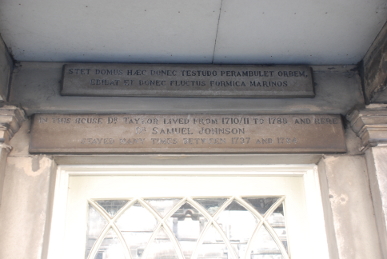 gateposts have pyramidal tops resting on skulls. We decide to leave this impressive building to another time. A long line of very impressive buildings is the old Queen Elizabeth Grammar School. Opposite Georgian Town houses line the road, one called “The Mansion” has a Latin inscription over the door which translates as “May this house stand until the tortoise walks around the world and until the ant drains the ocean waves”, and another stone block declaring Dr Johnson stayed here often with his good friend Dr Taylor. Samuel Johnson came from humble stock, a family that lived close to Ashbourne. At the turn of the 20th century there were folk here who could remember the Johnson brothers, two large men who were saddlers at the corner of Digg Street and were believed to be related to the good Doctor.
gateposts have pyramidal tops resting on skulls. We decide to leave this impressive building to another time. A long line of very impressive buildings is the old Queen Elizabeth Grammar School. Opposite Georgian Town houses line the road, one called “The Mansion” has a Latin inscription over the door which translates as “May this house stand until the tortoise walks around the world and until the ant drains the ocean waves”, and another stone block declaring Dr Johnson stayed here often with his good friend Dr Taylor. Samuel Johnson came from humble stock, a family that lived close to Ashbourne. At the turn of the 20th century there were folk here who could remember the Johnson brothers, two large men who were saddlers at the corner of Digg Street and were believed to be related to the good Doctor.

Sunday – Barnsley Canal – We arrived in Barnsley yesterday to celebrate Brigid’s birthday – I will be a gentleman and not mention which one! It is a large gathering of friends and family at a Ceilidh in Barnsley College, an all together fine affair. This morning I arise in darkness and set off to old stamping grounds. Up the familiar steps and onto the old pit site in Smithies Lane. Here things are less familiar simply because some trees which were saplings a few years ago have grown tall and filled out. This has a surprising effect on the landscape in terms of how short a time it takes for appearances to change. The paths have not changed though. Along to the canal bridge and off along the canal. It looks dry here, the reed beds are pale brown and there is stench of decay in the air. The scene is lightened now and again as the moon emerges from behind clouds. It is not as cold as yesterday. A Water Rail squeals like a stuck pig out on the valley bottom. A Wren ticks and another bursts into brief song. Back along the canal towards Smithies Lane. A Grey Heron flaps up from the bottom of the hill. The nearby allotments have been abandoned and look wrecked. All the work done by army cadets at the old lock-keepers house site has disappeared. As I approach Smithies Lane again, I muse that Maddy is my third dog to walk this path, following in Orphie and Dill the Dog’s footsteps.
Monday – Croft Ambrey – The rain has stopped, what little of it there was. Finches chatter overhead in the car park Beeches. The paths are barely damp and where the canopy remains thick and green, the leaf litter is dry and rustles underfoot. Some trees have shed their leaves, others remain green. Chirps and cheeps of Tits, brief burst of Robin song and distant caws of Carrion Crows are incidental to the overall quiet of the autumn wood. A breeze blows coolly over Croft Ambrey. The Leinthall quarry is silent – tea break? Indeed the whole world seems to have paused. Then a tipper lorry in the quarry moves, cattle cross a field to greet a Land Rover delivering feed and birds start chattering down the steep northern slope of the hillfort. Park House near the farm by the castle was originally two cottages built in the Arts and Crafts style and have been on a long lease. The lease has now reverted to the National Trust who are refurbishing the premises to allow it to be re-let on short-term leases. I was hoping to find some Field Mushrooms in the fields but it looks like it is too late, only one miserable, shrivelled specimen.
Friday – Mortimer Forest – The road to the Mortimer Forest passes through Orleton and Richards Castle. The Black Pool car 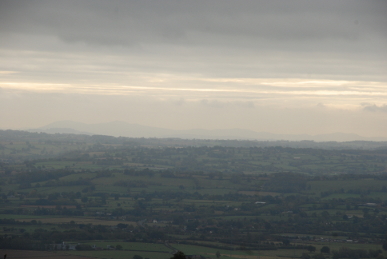 park lies just before Overton. As I pass Orleton a large flock of winter thrushes, probably all Fieldfares, flies over the bare fields. Masts are thickly arrayed between the village and Wooferton to the east. They were erected in 1943 to send short-wave transmissions to the French Resistance in the run-up to D-Day. After the war, they transmitted the BBC Overseas Service and the Voice of America. From here, Titterstone Clee stands on the skyline, its summit wreathed in cloud. The sky is grey over the forest but the sun is trying to break through. An occasional cheep breaks the silence. I am hot as I tramp ever upward towards High Vinnalls. The cloud has lifted above Titterstone Clee, although not very far and more lays right along the back of Brown Clee. To the west the tops of the hills and down into the valleys are full of mist. To the north Caer Caradoc stands dark and clear. To the south the distant hills are indistinct, the Malverns a pale grey colour with streaks of glowing sky above them. Meadow Pipits flit in the breeze, squeaking.
park lies just before Overton. As I pass Orleton a large flock of winter thrushes, probably all Fieldfares, flies over the bare fields. Masts are thickly arrayed between the village and Wooferton to the east. They were erected in 1943 to send short-wave transmissions to the French Resistance in the run-up to D-Day. After the war, they transmitted the BBC Overseas Service and the Voice of America. From here, Titterstone Clee stands on the skyline, its summit wreathed in cloud. The sky is grey over the forest but the sun is trying to break through. An occasional cheep breaks the silence. I am hot as I tramp ever upward towards High Vinnalls. The cloud has lifted above Titterstone Clee, although not very far and more lays right along the back of Brown Clee. To the west the tops of the hills and down into the valleys are full of mist. To the north Caer Caradoc stands dark and clear. To the south the distant hills are indistinct, the Malverns a pale grey colour with streaks of glowing sky above them. Meadow Pipits flit in the breeze, squeaking.
Wednesday – Leominster – A bright star-lit sky as I wander across the park by the Minster. Again I have to go and search for Maddy’s ball which she has lost in the darkness. Common sense tells me that it silly to play ball when it is this dark, but neither Maddy or I share much of this trait. Satellites are travelling across the sky – firstly Cosmos 2219, a rocket body launched in 1992, then Cosmos 304, another rocket body, this one launched in 1969. It seems wonderful that this object has been out there, circling earth day after day for 42 years! The bells chime half past six o’clock. To them, 42 years is a blink, having been rung for a thousand years, give or take a few years of silence as the clergy, monks and townspeople had their frequent disputes. However, on this day maybe they were in harmony as it is the Feast Day of St Edfrith, the monk who converted King Merewald to Christianity, resulting in the founding of Leominster Priory in 660CE. The date of the feast Day was recorded in the monastery’s Calendar which is preserved in a late Anglo-Saxon document called “Nero Aii”, housed in the British Museum.
Symonds Yat – This is a popular tourist spot, high above the River Wye and visiting at the school half-term ensured we were not alone! However, the views from the top of the cliffs of the great woods as they are turning into autumnal  reds, golds and umbers is a sight that should not be missed. Far below the river is a sinuous blue snake sliding past the hills. Tiny dots can be resolved through binoculars as Mallard and Mute Swans. Feral and Wood Pigeons are flying about the famous cliffs, so it seems clear the Peregrine Falcons are not present. Back down the path past the ramparts of an Iron Age hillfort. Whilst one is quite large, the others are not easy to see, being covered in trees and undergrowth. There are four ditches and ramparts dating from the early Iron Age. It is thought they were utilised by the builders of Offa’s Dyke and have been attributed to this Mercian king, but are far older. The ramparts crossed the road that lies to the east of the site but are much degraded on the eastern side. This road is considered to be of considerable age.
reds, golds and umbers is a sight that should not be missed. Far below the river is a sinuous blue snake sliding past the hills. Tiny dots can be resolved through binoculars as Mallard and Mute Swans. Feral and Wood Pigeons are flying about the famous cliffs, so it seems clear the Peregrine Falcons are not present. Back down the path past the ramparts of an Iron Age hillfort. Whilst one is quite large, the others are not easy to see, being covered in trees and undergrowth. There are four ditches and ramparts dating from the early Iron Age. It is thought they were utilised by the builders of Offa’s Dyke and have been attributed to this Mercian king, but are far older. The ramparts crossed the road that lies to the east of the site but are much degraded on the eastern side. This road is considered to be of considerable age.
Leominster – End of evening walk across a damp Grange with Maddy. Clouds are beginning to obscure the heavenly host of stars. Tawny Owls hoot around Grange House.
Thursday – Ryelands – Up to the path along the hill at Ryelands. It is still raining, which is very welcome as far as the garden is concerned. Common Pheasants run across the paddock, probably a dozen at least. Blue Tits chatter in the bushes. It is a sign of how seldom I come up to this track that the big field that runs down to Passa Lane is covered with a maize crop – it was grass last time I was here. The maize does not look particularly high, probably another victim of the low rainfall we have suffered this year. Rooks call as they pass over. Along Cock Croft Lane, which is just a track now and down to the Hereford Road. The track down the hill from Arrow Heights has been resurfaced.
Friday – Home – A cold and misty start to the day. Out comes the last of the Runner bean plants. The large mound of stems and leaves is dragged around to chicken run and dumped inside. The hens cluck contentedly as they scratch the mound and munch the leaves. I clean up the ground, removing the weeds and as much of the grass a possible, but the roots are running deep and thickly. Other than digging right down and sifted the lot, I am not going to get rid of these roots easily. By now my fingers are painfully cold despite the gloves I am wearing. Later on, in the afternoon it has warmed considerably with bright sunshine. Garlic is sown and some Broad beans that have been sprouted in the greenhouse are planted out. A few lettuce seedlings go under a cloche. It is St Jude’s Day, the patron saint of lost causes. I hope this is not an omen for my planting. However, tradition also says it always rains on St Jude’s Day so the bright sun seems to remind us not to pay too much attention to old tales and sayings. A cawing overhead comes from a Carrion Crow harassing a Common Buzzard.
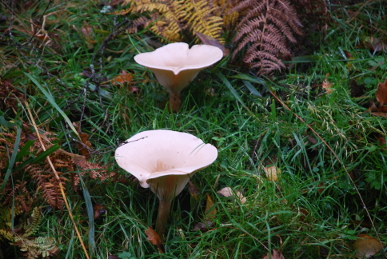
Monday – Croft – October ends in true autumnal fashion. The wind blows through the tops of the trees in the Fish Pool Valley but it is quiet down here on the valley floor. The leaf litter is sodden after the weekend’s rain. Rooks caw and tits twitter. A Nuthatch calls high in the canopy and short bursts of song come from a Wren hidden in the undergrowth. A barking Raven flies over. Up through the green, copper and gold Beech wood. Up the forestry track between Lyngham Vallet and Bircher Common. The rain has encouraged some fungi to rise up out of the soil, but not many. A large 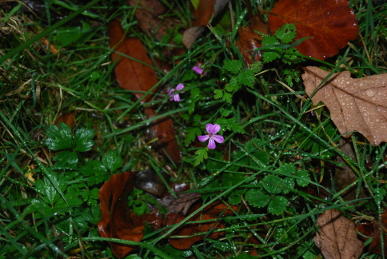 dish-shaped pair sit by the path. As usual I am having difficulty with identification – Lactarius or Clitocybe probably! Very few flowers are still around, just some tiny pink Herb Roberts peeking through the grass. The bracken at the open area between Leinthall and Bircher Commons which was cut back in the summer has regrown thickly. From the hillfort the distant hills are hazy, cloud hangs low over them in a rumpled sheet. The old trees at the western end of the hillfort are in different stage of leaf shedding. Oaks retain most of their leaves which are mainly still green, the old grey Hornbeams with their smoothly wrinkled boughs have most of their leaves but these are yellow, the Ash however have very few leaves just bunches of keys. Tonight is Halloween, the ancient festival of Samhain now much debased by the American Trick or Treat nonsense. The original Celtic festival which involved large fires on the hills was held now because it was thought on this night the earthly and spirit worlds were very close and spirits could cross from their domain into ours. Up here on Croft Ambrey it is not hard to imagine how a cold, dark night could inspire thoughts of otherwordliness.
dish-shaped pair sit by the path. As usual I am having difficulty with identification – Lactarius or Clitocybe probably! Very few flowers are still around, just some tiny pink Herb Roberts peeking through the grass. The bracken at the open area between Leinthall and Bircher Commons which was cut back in the summer has regrown thickly. From the hillfort the distant hills are hazy, cloud hangs low over them in a rumpled sheet. The old trees at the western end of the hillfort are in different stage of leaf shedding. Oaks retain most of their leaves which are mainly still green, the old grey Hornbeams with their smoothly wrinkled boughs have most of their leaves but these are yellow, the Ash however have very few leaves just bunches of keys. Tonight is Halloween, the ancient festival of Samhain now much debased by the American Trick or Treat nonsense. The original Celtic festival which involved large fires on the hills was held now because it was thought on this night the earthly and spirit worlds were very close and spirits could cross from their domain into ours. Up here on Croft Ambrey it is not hard to imagine how a cold, dark night could inspire thoughts of otherwordliness.